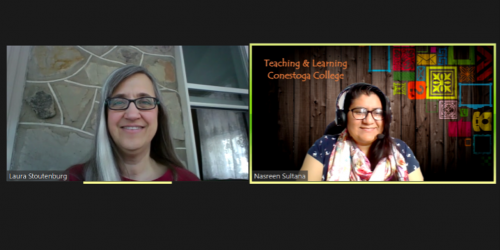
Making a Comeback: How to Get Back on Track After a Rocky Start to the Semester
Did you get off to a rocky start to the semester? Finding it challenging to connect with your students to foster a productive learning environment and experiencing classroom management challenges? A rocky start can happen for a variety of reasons some that are in our control and some that are not, however, know that you’re not alone and that there are supports in place to help you and your students. In this post, we will discuss potential ways to overcome a rocky start to the semester and re-establish the relationship with students and get back on track for a strong finish.
Reflect and Reset: Take time to reflect on the first few weeks (e.g. what went wrong and identify specific areas for improvement). This involves honestly assessing your teaching methods, classroom management techniques, and interactions with students. By pinpointing what didn’t work, you can develop a clear plan to address these issues and make necessary adjustments. Do you know students’ names? It’s not too late to begin using name tents and addressing students by name in class. This not only helps with you getting to know them, but it also assists with their engagement/attention in the classroom. What about lesson planning? Have you prepared students for collaborative active learning? It’s not too late to work with a Teaching & Learning Consultant to assist with lesson planning, student engagement and classroom management.
Open Communication: Address the situation with your students. Acknowledge the rocky start and express your commitment to improving the classroom environment. This transparency can help build trust and show students that you are dedicated to creating a positive learning experience. You can send out an announcement and review classroom expectations (or create one if you haven’t already done so). Encourage students to share their perspectives and suggestions for improvement. You can do this using a zoom poll if online or a Mentimeter (open-ended or Start-Stop-Continue) in class so students can remain anonymous. Once the expectations are set, take notes and send them via email and post them in your course shell.
Consistent Routines: Establish and maintain clear, consistent routines. Having a predictable structure can help students feel more secure and focused, reducing anxiety and disruptive behavior. Clearly communicate your expectations and stick to them to create a stable learning environment. Set a clear agenda each week, write it on the board and include breaks every hour as part of the agenda.
Leverage Conestoga’s Resources
First, you’re not alone! Conestoga has a variety of supports in place to help students thrive both inside and outside the classroom. Leveraging these supports will assist students in further developing their study skills, be more productive in the classroom and get the non-academic related support they need that exists outside of faculty’s academic portfolios. It is also important to note and it make it clear to students that these resources are included as part of their tuition!
Here are a few resources that you can share with your students in the classroom (embed these in your course resources or slidedecks) and include them in a weekly announcement.
Library Services: Librarians can provide valuable resources and support for both you and your students, helping to enhance their research capabilities and academic success. This partnership can also introduce students to the wealth of information available through the library such as peer tutoring, 1-1 support for research (academic integrity, writing and citing), study skills, and math help. Librarians are also a great asset to invite into your classroom as guest speakers!
Student Success Services & Referrals: Many faculty have reported that referring students to a student success advisor has been impactful for student success and progress. When can faculty refer to an advisor? Examples include: if students are not attending class and you have emailed them with no response, if students are not submitting assessments and/or failing assessments, etc. The Student Success Advisors can assist students with academic advising (e.g. managing course loads, assessments, etc.), getting involved in college wide activities, career services and referrals to student wellness. Check out the Success Services Map that shows all that they offer!
Counseling Services: Sometimes, behavioral issues stem from personal challenges. Encourage students to seek support from counseling services if they are facing personal difficulties that affect their academic performance. Providing information about these services can show students that you care about their overall well-being. Confidential, one-to-one appointments with counsellors are available to help students work through issues affecting their mental health. There is no cost to meet with a counsellor and appointments can be in-person, virtual or by telephone at all campuses.
Teaching and Learning Workshops and Courses: Participate in professional development opportunities within the Teaching and Learning department focused on classroom management, active learning, lesson planning, student engagement, and many more! These workshops and micro-credentials courses can provide new strategies and insights that can help you improve your teaching practices and better manage your classroom. You can also meet with a Teaching and Learning Consultant for a 1:1 meeting!
Re-Build a Positive Classroom Environment
- Community Building Activities: Even if it’s later in the semester you can still include short icebreaker activities. Take a few minutes at the start of class to see how things are going for students and open a dialogue to encourage students to take care of themselves and offer how you can help. For example, you can share as you feel comfortable about your favorite activities, hobbies or potential struggles you faced while in post-secondary and how you overcame them. If you’re worried about time being taken away for addressing key learning areas, start with a content-based icebreaker or bridge-in.
- Positive Reinforcement: Recognize and reward positive behavior. This can be done through verbal praise, small rewards, or acknowledgment. Positive reinforcement encourages students to continue exhibiting good behavior and contributes to a more positive classroom culture.
- Active Learning Techniques: Use group work, discussions, and hands-on activities to keep students engaged. Active learning strategies can make lessons more interesting and help students retain information better. Encourage participation and collaboration to make learning a dynamic and interactive process.
Self-efficacy, introduced by Albert Bandura in 1977, is the belief in one’s ability to execute behaviours necessary to achieve specific goals. It reflects confidence in controlling one’s motivation, behaviour, and social environment, influencing how people think, feel, and act. Bandura proposed that there were four components of self-efficacy:
- Mastery Experiences: Success builds strong self-efficacy, while early failures can undermine it.
- Vicarious Experiences: Observing others succeed boosts belief in one’s own abilities.
- Social Persuasion: Encouragement from others can enhance self-efficacy.
- Emotional and Physiological States: Positive mood improves self-efficacy, while stress and fatigue can weaken it.
Self-efficacy is crucial for teachers as it significantly influences their motivation, perseverance, and resilience. Teachers with high self-efficacy are confident in their ability to engage students, manage classroom behaviour, and adapt lessons to meet diverse needs. They are proactive in seeking professional development opportunities and are more likely to implement innovative teaching methods, leading to positive student outcomes.
Rebuilding relationships and improving the classroom experience for you and your students is a process that requires patience, consistency, and a willingness to adapt. Acknowledging and beginning the process to get back on track and finish strong shows resiliency and growth in your teaching journey.
References:
Bandura, A. (1977). Self-efficacy: Toward a unifying theory of behavioral change. Psychological Review, 84(2), 191-215.
Brillinger, K. (2023). Preventing classroom management challenges. https://tlconestoga.ca/preventing-classroom-management-challenges/
Conestoga College Student Success Services: https://studentsuccess.conestogac.on.ca/
Conestoga College Student Success Services Counselling: https://studentsuccess.conestogac.on.ca/myWellness/counselling
Cornell University Center for Teaching Innovation. (2024). Managing classroom conflict. https://teaching.cornell.edu/resource/managing-classroom-conflict
Paulson, E. (2023). Students talking in an in-person class. https://tlconestoga.ca/students-talking-in-class/
Spring, L., Vanthuyne, A. (2023). Strategies and scripts you can use when encountering common classroom management challenges. https://tlconestoga.ca/strategies-and-scripts-you-can-use-when-encountering-common-classroom-management-challenges/
Stoutenburg, L. (2023). The First Two Weeks: Basic Classroom Expectations. https://tlconestoga.ca/the-first-two-weeks-basic-classroom-expectations/






